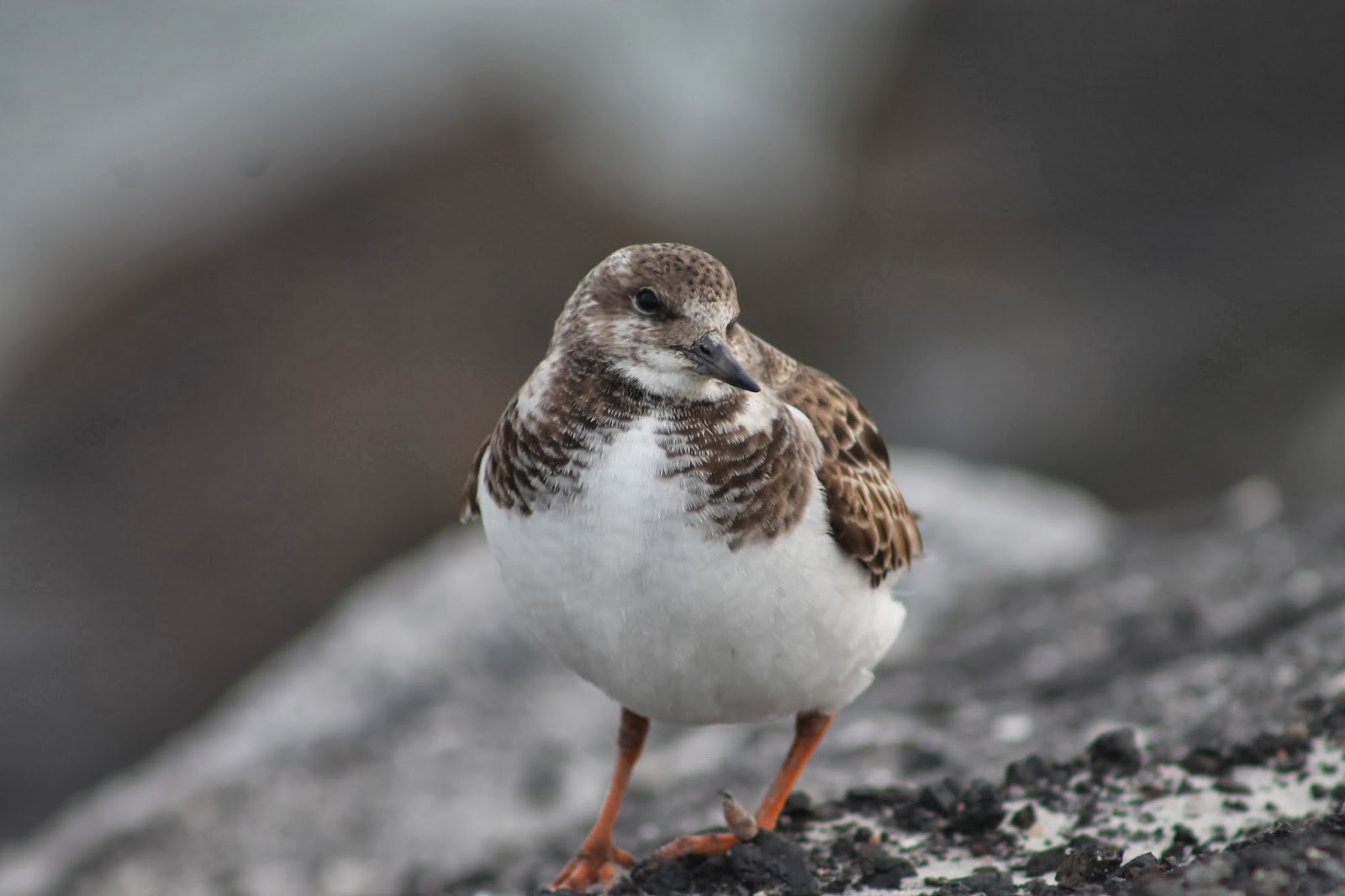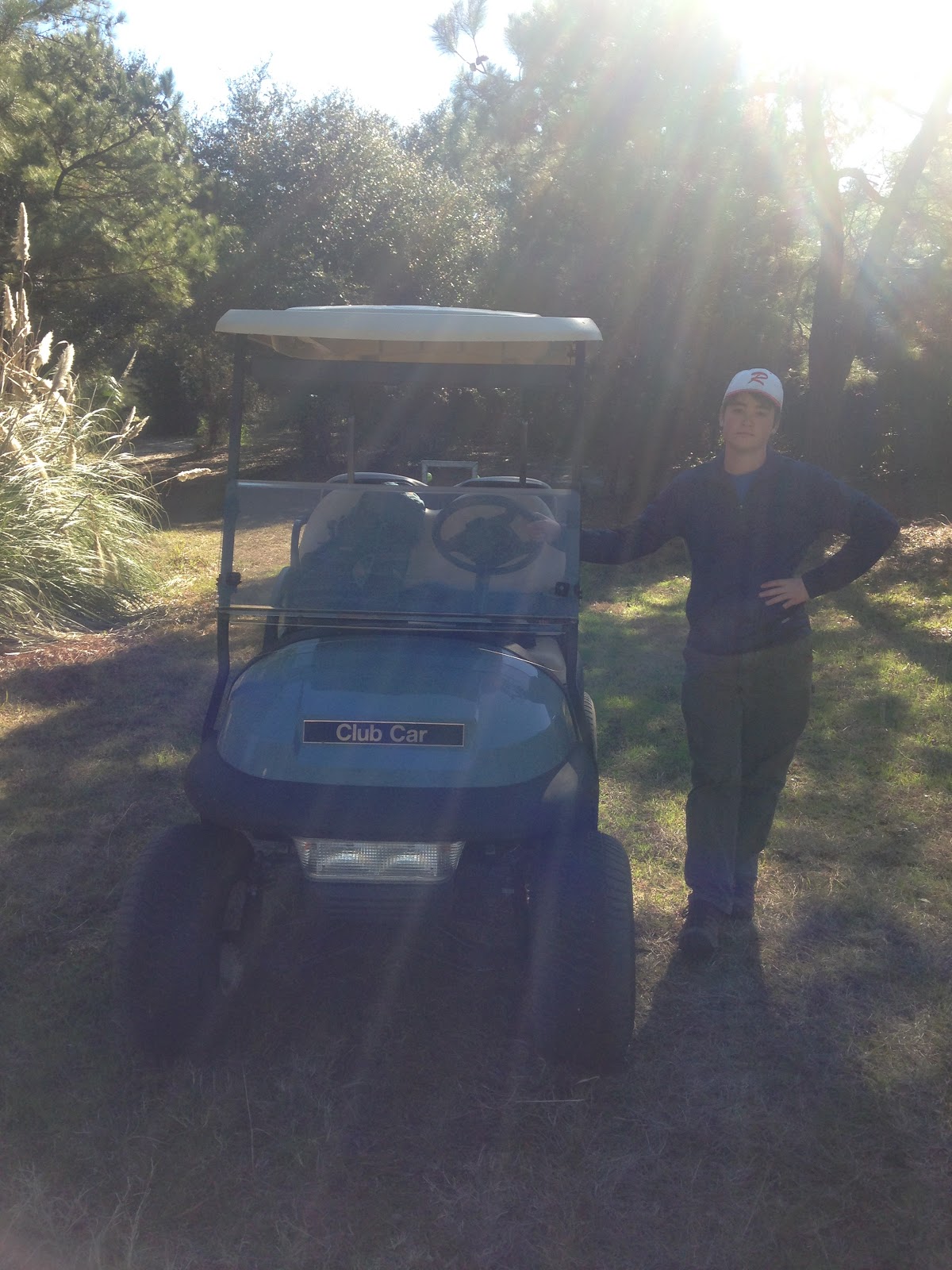We all three left the boardwalk with the Virginia Rail as a lifer and made our way to the beach. After the mile walk down the beach the jetty was finally insight, we had a new companion on our big day team who was there to greet us: a curious Ruddy Turnstone, who we named Levi. Levi was not nearly as skittish as the rails and kept following us around on the jetty.
 |
| Levi, the curious Ruddy Turnstone. |
After we filled up our memory cards with Levi, we got to some scoping. We walked up and down the jetty as the strong winds pushed waves over the side of the jetty spraying us. We quickly spotted all three scoter species: Surf, Black, and White-winged Scoter.
 |
| Lucas Scoping Scoters |
 |
| Sam checking out Loons |
After the Scoter Grand Slam, a few Common Loons, and a Common Eider; we quickly got out of the way of the strong winds and made our way to a few trails behind the sand dunes. There was no success with spotting any Seaside or Nelson’s sparrows just Savannahs plus an American Kestrel. After the long walk back, we hopped in the car and drove towards the freshwater pond, Mullet Pond, to scope for more waterfowl. The pond had a nice variety from Blue and Green-winged Teal, Scaup, Shovelers, and even American White Pelicans feeding in a rhythmic motion each bobbing their heads in and out of the water one after the other.
 |
| Mullet Pond, filled with waterfowl |
Our last stop in Huntington was at the feeders to see if any Painted Buntings; a cousin of the cardinal dressed in a beautiful plumage of red, green, and blue that is summer resident; might have stuck around for the winter. However, there were none, but as we were walking in the parking lot to leave, a small passerine with an olive colored back and blue head stuck out like a sore thumb in the never ending flock of Yellow-rumped Warblers. I brought my binoculars against my eyes, and a Blue-headed Vireo was hopping around in the tree limbs of a cedar tree. Then another warbler made an appearance in the cedar tree, a Black-and-White Warbler, two birds I thought we would miss. We left the park at 11:00 a.m. satisfied that we had quality views of all 72 species of birds.
We arrived at DeBordieu after treating ourselves to a nice lunch of hot dogs and milkshakes, ready to bird another 28 species strong, at least to break 100. I knew a perfect place to start, a dirt road that runs parallel to a small, shrubby canal that leads you out to the marsh. We saw an immature Wood Stork, Killdeer, a female Wood Duck, and a Seaside Sparrow that flushed out of the marsh. These were all birds we didn’t see for the rest of the day. However, there were some others that we encountered little to none, Woodpeckers. There is patch of beautiful Longleaf Pine forest in DeBordieu that just has woodpecker written all over it on the tree trunks, but we only heard a Downy Woodpecker call from a far distance. After our frustration with woodpeckers, we got another great photo opt. with this Anhinga:
Once the Anhinga flew off, we sped the car down the road and checked a spot we knew was reliable for our 100th bird: Black-crowned Night Herons along with two Eurasian Collared Doves as 99th. By dinner, we had broken our previous record of 102 species that we set in the OBX of NC. We were munching on our pizza at 106 species for the day, with Least Sandpiper being a nice surprise and a Northern Harrier being our last bird seen in broad daylight. The day’s not over yet; we still had some nocturnal numbers to add to our list.
Once the Anhinga flew off, we sped the car down the road and checked a spot we knew was reliable for our 100th bird: Black-crowned Night Herons along with two Eurasian Collared Doves as 99th. By dinner, we had broken our previous record of 102 species that we set in the OBX of NC. We were munching on our pizza at 106 species for the day, with Least Sandpiper being a nice surprise and a Northern Harrier being our last bird seen in broad daylight. The day’s not over yet; we still had some nocturnal numbers to add to our list.
We returned to the dirt road running parallel to the pine forest where we had heard Eastern Screech Owls two nights ago. Three responded to our playback with their whiny, monotonic trill. By the end of the night Screech Owl was the only owl that decided to respond, and we were able to get another cousin in the Rail family to let out a quick call through the thick and grassy marsh later that evening, a Sora. Thus the climax of the weekend had ended once the Sora responded. The Bird Nerd Herd now has a new Big Day PR of 108 bird species and learned another step or two of how a big day should be done. The marshy jewel that has been the subject of many chapters in my birding stories, DeBordieu, did not disappoint as usual. It would not of been possible if we did not have the golf, perfect chasing birds in DeBordieu:
Here is the chronological order of bird species we saw on our Big Day.(Thanks Lucas)
Huntington Beach State Park
- Great Blue Heron
- Clapper Rail
- Hooded Merganser
- Sedge Wren
- Snowy Egret
- Little Blue Heron
- Greater Yellowlegs
- Virginia Rail
- Tricolored Heron
- Tree Swallow
- American White Pelican
- White Ibis
- Ring-billed Gull
- Double-crested Cormorant
- Forster's Tern
- American Crow
- Boat-tailed Grackle
- Yellow-rumped Warbler
- Carolina Chickadee
- Mourning Dove
- Northern Cardinal
- Tufted Titmouse
- Carolina Wren
- White-throated Sparrow
- Dunlin
- Willet
- Semipalmated Plover
- Northern Gannet
- Sanderling
- Red Knot
- Bonaparte's Gull
- Brown Pelican
- Pied-billed Grebe
- Herring Gull
- Horned Grebe
- White-winged Scoter
- Black Scoter
- Ruddy Turnstone
- Red-breasted Merganser
- Surf Scoter
- Common Loon
- Common Eider
- Red-throated Loon
- Savannah Sparrow
- Great Egret
- Black-bellied Plover
- Short-billed Dowitcher
- American Kestrel
- Belted Kingfisher
- Lesser Scaup
- Brown Thrasher
- Blue Jay
- Northern Mockingbird
- Northern Flicker
- Mute Swan
- American Wigeon
- Gadwall
- Redhead
- Northern Shoveler
- Green-winged Teal
- Blue-winged Teal
- Lesser Yellowlegs
- American Coot
- Ruddy Duck
- Greater Scaup
- Bald Eagle
- Turkey Vulture
- American Robin
- Golden-crowned Kinglet
- Osprey
- Blue-headed Vireo
- Black-and-white Warbler
Debordieu Colony
- Black Vulture
- Wood Stork
- Eastern Towhee
- Wood Duck
- Red-bellied Woodpecker
- Chipping Sparrow
- Red-tailed Hawk
- Red-winged Blackbird
- Song Sparrow
- Killdeer
- Seaside Sparrow
- Common Gallinule
- American Black Duck
- Brown-headed Nuthatch
- Eastern Bluebird
- American Goldfinch
- Yellow-bellied Sapsucker
- Pine Warbler
- Common Grackle
- White-breasted Nuthatch
- Fish Crow
- House Finch
- European Starling
- Cedar Waxwing
- Eastern Phoebe
- Anhinga
- Eurasian Collared-Dove
- Black-crowned Night-heron
- Mottled Duck
- House Wren
- Great Black-backed Gull
- Downy Woodpecker
- Least Sandpiper
- Northern Harrier
- Eastern Screech-Owl
- Sora



No comments:
Post a Comment